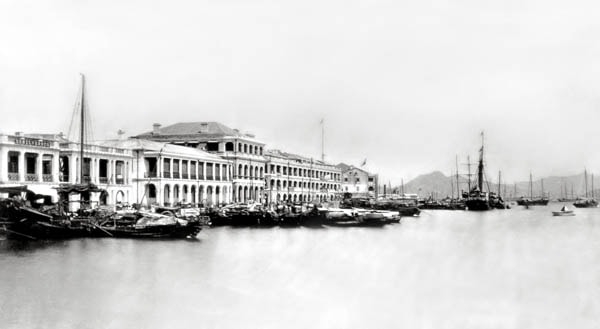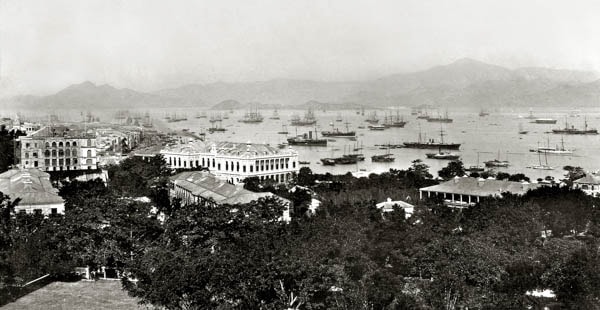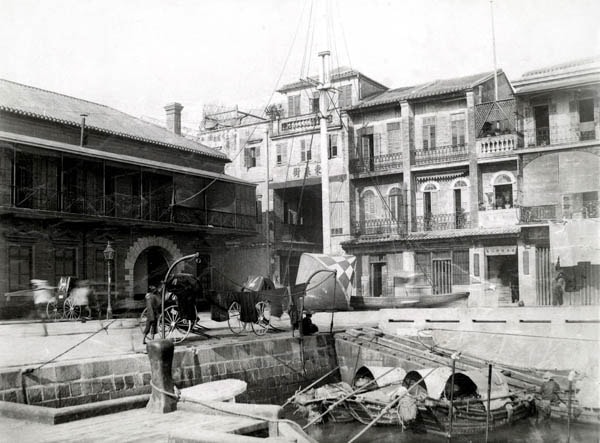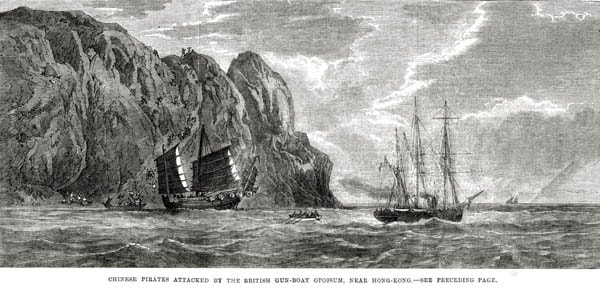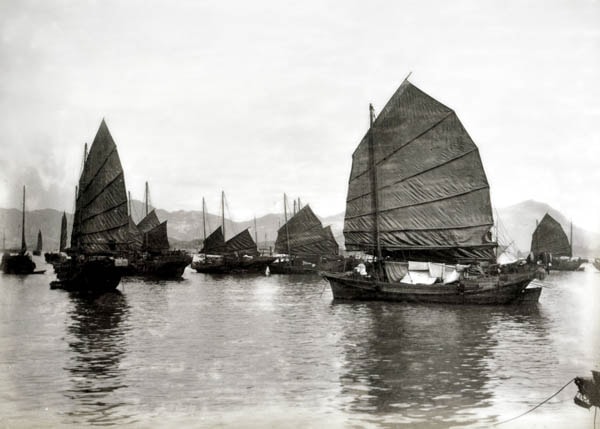| Harbour Masters | (within the period 1860 to 1898) |
|---|---|
| Henry G. Thomsett | 1861-1863 HM, MM, EO 1864-1887 HM, MM, E&CO |
| Robert M. Rumsey | 1888-1903 HM, MM, E&CO, I&EO |
(HM-Harbour Master MM-Marine Magistrate E&CO-Emigration and Customs Officer EO-Emigration Officer I&EO-Imports & Exports Officer)
In 1862, the following posts were created: Boarding Officer, Cargo Boat Inspector, Signalman (stationed on the Peak), Chinese Interpreter, and Shroff. The Marine Surveyor’s Office was set up in 1879 to conduct surveys, regulate the qualifications of engineers, examine the carriage of dangerous goods, and regulate medicine and medical stores. In 1887, an Imports and Exports Office was established under the Harbour Master to record and control shipments of opium in and out of the city pursuant to the signing of the Additional Article to the Chefoo Agreement of 1876 in 1885. The Harbour Master became the Imports and Exports Officer in addition to his other duties. In 1887, the Harbour Master’s Office was headed by the Harbour Master, who was at the same time the Marine Magistrate, the Emigration Officer, and the Customs Officer. He was supported by an Assistant Harbour Master. Under them, the Harbour Master’s Office was divided into the following branches or offices:[6]
- Marine Surveyor’s Office (Government Marine Surveyor) supported by a clerk and messenger
- Gunpowder Department (Officer and Superintendent)
- Inspector of Junks and Cargo Boats and his Assistant
- First Boarding Officer and Second Boarding Officer
- First Clerk, Second Clerk, etc.
- Lighthouses (collector of light dues)(lighthouse keepers)
- Signalman, Indian interpreter, Chinese interpreter, Chinese Writers, Shroff, Constables, etc.
- Steam Launches (engineer, stoker, coxswain and sailors).
In 1887, apart from the abovementioned branches and posts, an Imports and Exports Office was established, headed by a superintendent and supported by clerks and messengers. In 1907, the signalman, inspector of junks, boarding officers and the clerks were grouped under a newly formed branch known as the Harbour Office.
Meanwhile, an Observatory was established on Elgin Hill, Tsim Sha Tsui, in 1883 to provide weather forecasts of Hong Kong. Formerly, it was the duty of the Harbour Master’s Office to provide reports on typhoons.[7]
Harbour Master’s Office
In 1866, a permanent brick and stone building on Tung Loi Lane was opened. The new building, however, collapsed in 1873, and had to be rebuilt a year later. In the 1880s and 1890s, the Harbour Master’s Office expanded with the establishment of more branches and more staff. Meanwhile, the old building gradually became dilapidated, and was losing its harbour view following the reclamation in Central. A new building with better facilities, erected at the junction of Connaught Road Central and Rumsey Street, was opened in 1906.[8]
Branch harbour stations and steam launches
Apart from the main office of the Harbour Master’s Office, branch harbour stations were set up for better control of the harbour. In 1865, harbour stations were opened in Shau Kei Wan, Stanley and Aberdeen. In the following year, the Yau Ma Tei and Hung Hom stations were opened. After the lease of the New Territories, seven harbour stations were established in Sham Shui Po, Cheung Chau, Tai O, Tai Po, Long Ket, Deep Bay and Sai Kung. Meanwhile, to supplement the work of branch stations, steam launches were acquired to patrol the harbour and discharge inspection duties. In 1898, there were four steam launches, namely the Victoria, the Hilda, the Lily and the Daisy. They were manned by engineers, firemen, coxswains, stokers and sailors. Prior to the introduction of steam launches, all duties in the harbour were discharged on board pulling boats.[9]
Lighthouses
The first lighthouse was set up at Cape D’Aguilar in April 1875. Located at the south-eastern point of Hong Kong Island, it had a first-order[10] fixed light that guided ships approaching Victoria Harbour from the south-east after nightfall. Three months later, a fourth-order fixed light was set up on Green Island to help ships approaching the harbour from the west. In 1876, a sixth-order fixed light was erected on Cape Collinson at the eastern tip of Hong Kong Island. In 1892, a first-order revolving light was installed on Gap Rock, a Chinese territory 30 miles south of Hong Kong. In 1893, the Chinese Government set up a lighthouse on Waglan Island, three miles east-south-east of Cape D’Aguilar. It had a first-order double flashing light. As a result, the Cape D’Aguilar lighthouse was discontinued in 1896. The Gap Rock and Waglan lighthouses were taken over by the Harbour Master’s Office after the leasing of the New Territories in 1898. The lighthouses were looked after by lighthouse keepers.[11]
Ordinances relating to shipping and control of the harbour were passed and enacted from 1860 to 1898: [12]
- No. 15 of 1860: An ordinance for the registration and regulation of boatmen and others employed on licensed cargo boats, and for the survey of such boats
- No. 13 of 1865: An ordinance for the rendition in certain cases of Chinese subjects charged with piracy
- No. 6 of 1866: An ordinance for the better regulation and control of certain vessels frequenting the waters of Hong Kong
- No. 9 of 1866: An ordinance to make provision for the more effectual suppression of piracy
- No. 1 of 1868: An ordinance for the suppression of piracy
- No. 2 of 1868: An ordinance to enable the Governor to co-operate with the Chinese authorities for the suppression of piracy
- No. 2 of 1870: An ordinance to enable the Governor to co-operate with the Chinese authorities for the suppression of piracy
- No. 8 of 1871: An ordinance on Chinese passengers
- No. 3 of 1873: An ordinance on Chinese emigrant ship fittings
- No. 5 of 1873: An ordinance on Chinese emigrant ships
- No. 17 of 1873: An ordinance on Hong Kong lighthouses
- No. 1 of 1874: An ordinance to empower the Governor to exercise certain powers under the Merchant Shipping Act, 1873
- No. 1 of 1876: An ordinance to amend the law relating to Chinese passenger ships and the conveyance of Chinese emigrants
- No. 1 of 1878: An ordinance on Chinese passengers
- No. 8 of 1879: An ordinance on merchant shipping consolidation
- No. 3 of 1880: An ordinance on Merchant Shipping Consolidation Ordinance amendment
- No. 16 of 1882: An ordinance on Merchant Shipping Consolidation Ordinance amendment
- No. 19 of 1882: An ordinance on Merchant Shipping Consolidation Ordinance amendment
- No. 9 of 1883: An ordinance on Merchant Shipping Consolidation Ordinance amendment
- No. 14 of 1884: An ordinance on Merchant Shipping Ordinance amendment
- No. 19 of 1884: An ordinance to authorise Catchick Paul Chater to construct piers and wharves in Victoria Harbour and to confer upon him certain other powers and privileges
- No. 20 of 1886: An ordinance on Harbour Regulations
- No. 1 of 1889: An ordinance on to consolidate the law relating to Chinese passenger ships and the conveyance of Chinese emigrants
- No. 26 of 1891: An ordinance on merchant shipping consolidation
- No. 36 of 1899: An ordinance to consolidate and amend the laws relating to merchant shipping, the duties of the Harbour Master, the control and management of the waters of the Colony, and the regulation of vessels navigating the same.
Hong Kong and its surrounding waters had long been infested with pirates, who posed a serious threat to ships plying the nearby waters, thereby affecting trade adversely. It was said that an average of fourteen serious cases were reported annually. Of these, Chui A-po (徐亞保), active in the late 1840s, and Wong Ma-chow (黃墨洲), active in the mid-1850s, were the most notorious.[13] As early as 1847, an ordinance for the suppression of piracy was passed, being the first ordinance of such nature passed and enacted in Hong Kong. However, it was disallowed by the Home Office the following year. Ordinances for more effectual suppression of piracy were enacted in 1865, 1866, 1868 (two ordinances passed in the same year) and 1870 respectively. Ordinances No. 2 of 1868 and No. 2 of 1870 enabled the Governor to co-operate with the Chinese authorities in the suppression of piracy.
In 1860, the registration of junks and small craft, formerly under the purview of the Registrar General’s office, was put under the jurisdiction of the Harbour Master’s Office, and the first piece of legislation regarding control of junks was enacted. This provided for the licensing of boatmen and their cargo boats, as well as the control of the movement and activities of junks.[14] The ordinance was also a measure to suppress piracy. However, the enactment of the ordinance in 1860 led to discontent among the cargo boatmen, who staged a strike in protest. This ordinance was supplemented by another one in 1866, which further stipulated that anchorages for junks should be designated, and that no junk was allowed to leave the waters of Hong Kong without clearance from the Harbour Master.[15]
Ordinance No. 8 of 1879 consolidated and amended laws relating to merchant shipping, the duties of the Harbour Master, the control and management of the waters of Hong Kong, as well as the regulation of vessels navigating the same.[16] It had four parts: Part I dealt with merchant shipping and seamen (regulations on British and colonial ships: regulations concerning safety, Marine Courts and Court of Survey, shipping and discharge of seamen, boarding houses for seamen, health of seamen, medicine and medical stores, and distressed seamen); Part II dealt with management and control of the waters of Hong Kong in which vessels navigated (duties of masters, lighthouses, buoys or beacons, importation and storage of gunpowder); Part III concerned the regulation of junks and small boats (licensing of junks, licensing of boats, cargo boatmen, etc., deck and load lines); and Part IV dealt with general issues like fees, repealing clause, etc. This ordinance was subsequently repealed and replaced by Ordinances No. 26 of 1891 and No. 36 of 1899. Meanwhile, Ordinance No. 1 of 1889, the Chinese Emigration Ordinance, was introduced with the intention of improving the condition of Chinese passengers seeking emigration and securing more humane treatment for them.
Notes:
- [6]Information extracted from the Harbour Master’s annual reports from Hong Kong Sessional Papers for 1887 and 1907.
- [7]Ho Pui-yin, Weathering the Storm: Hong Kong Observatory and Social Development (Hong Kong: Hong Kong University Press, 2003), pp. 35-43.
- [8]Arnold Wright, Twentieth Century Impressions of Hong Kong : History, People, Commerce, Industries and Resources (Singapore: Graham Brash, 1990), pp. 188-189.
- [9]Ibid., p.192.
- [10]Lights on the dioptric system are classified according to their power, which depends on the focal distance from the centre of the burner to the lenses. According to the British system the focal distance in diameter of the first order is 1,840mm, the second order 1,400mm, the third order 1,000mm, the fourth order 500mm, the fifth order 375mm, and the sixth order 300mm.
- [11]Arnold Wright, Twentieth Century Impressions of Hong Kong : History, People, Commerce, Industries and Resources, p.194.
- [12]‘Chronological Table of Ordinances’, The Laws of Hong Kong, Revised Edition 1964 (Hong Kong: The Government Printer, 1966).
- [13]Endacott, A History of Hong Kong, p. 131; 馬沅:〈防禦海盜事略〉,載於《香港法制史實》(香港:華僑日報,1936),頁25-35。
- [14]An ordinance for the registration and regulation of boatmen and others employed on licensed cargo boats, and for the survey of such boats, Hong Kong Government Gazette, 24 November 1860.
- [15]Ordinance No. 6 of 1866. An ordinance enacted by the Governor of Hong Kong, with the advice of the Legislative Council for the better regulation and control of certain vessels frequenting the harbour, Hong Kong Government Gazette, 14 August 1866.
- [16]An ordinance enacted by the Governor of Hong Kong, with the advice of the Legislative Council thereof, to consolidate and amend the laws relating to merchant shipping, Hong Kong Government Gazette, 14 January 1879.
Part 1 Chapter 3.2 - The Harbour Master’s Office and its development from 1860 to 1898

